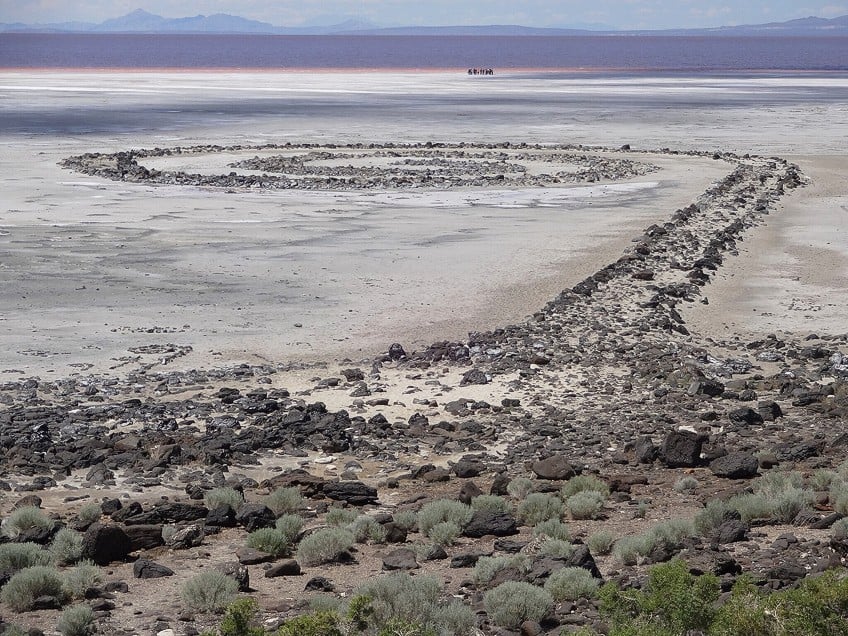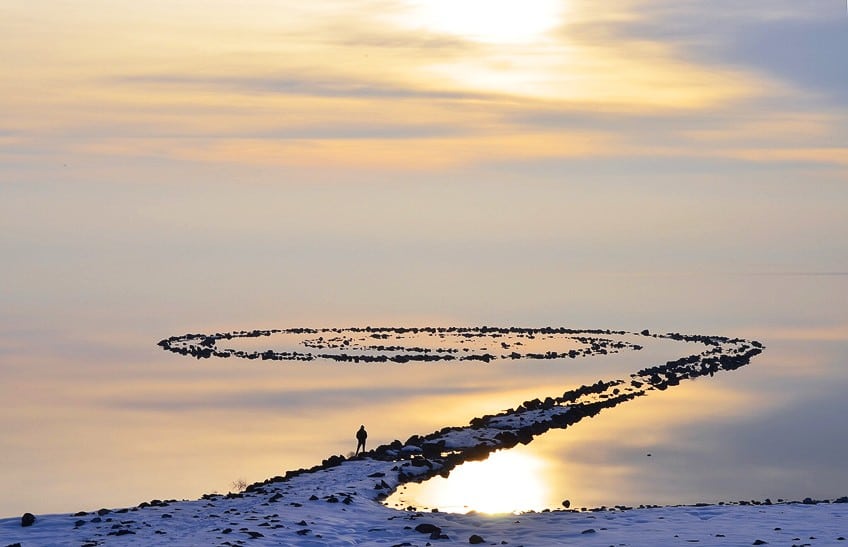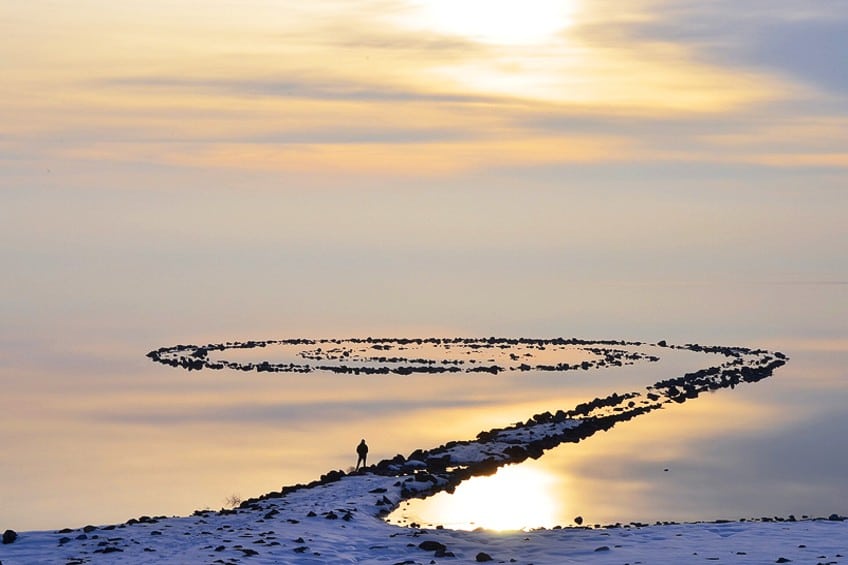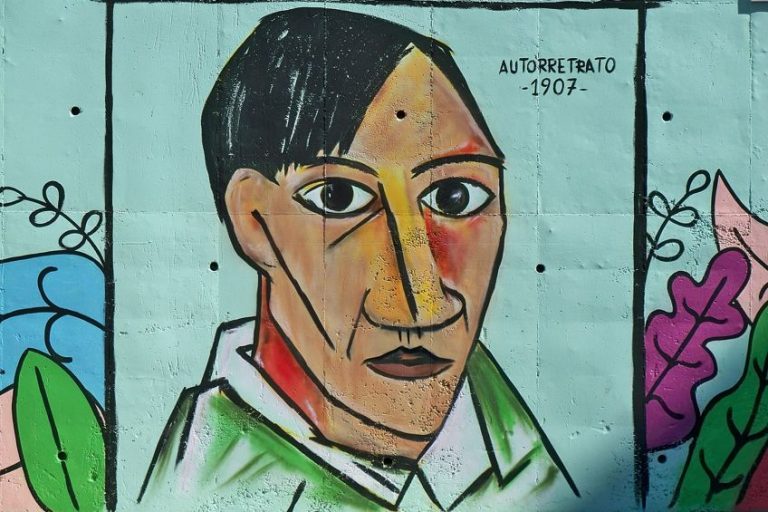“Spiral Jetty” by Robert Smithson – The Famous Spiral Jetty in Utah
The article below will explore the famous Spiral Jetty by Robert Smithson, created and constructed in 1970. It was to be one of the Land artist’s final works on this earth (literally and figuratively) before his death in 1973.
Artist Abstract: Who Was Robert Smithson?
Robert Smithson’s date of birth was January 2, 1938, and he died on July 20, 1973, in Passaic, New Jersey. He started his art career as a painter and was interested in a wide variety of topics that ranged from classics to science fiction.
He also developed as a conceptual artist over time and was influenced by the Minimalist art movement becoming one of the pioneering Land artists. He also produced extensive written works around art and various theories. He was married to Nancy Holt, who was also an installation artist and sculptor.
Spiral Jetty (1970) by Robert Smithson in Context
| Artist | Robert Smithson |
| Date Painted | 1970 |
| Medium | Basalt rock, earth, and water |
| Genre | Sculpture |
| Period/Movement | Land Art movement |
| Dimensions | 1,500 feet x 15 feet wide |
| Series/Versions | N/A |
| Where Is It Housed? | Rozel Point, Great Salt Lake, Utah, United States |
| What It Is Worth | Donated to Dia Art Foundation in 1999 |
The article below will discuss the sculpture Spiral Jetty by Robert Smithson. This is not the average marble sculpture that you will find in a gallery, but a larger-than-life, immersive, land sculpture that you can walk on. In the contextual analysis below, we look further at why and how Smithson created this gigantic coil, followed by a formal analysis and visual description and how the art elements compose it.
Contextual Analysis: A Brief Socio-Historical Overview
Robert Smithson was active as an artist during the mid-1900s, initially working within the medium of drawing and painting with an Abstract Expressionist style. His artistic approach changed however when he became more familiar with Minimalism and started creating sculptures.
Virginia Dwan, his art dealer, reportedly introduced him to several Minimalist artists who were also sculptors, for example, Claes Oldenburg, Carl Andre, and Nancy Holt whom he married in 1963.
As Smithson’s artistic style evolved from two-dimensional to three-dimensional artworks, he increasingly incorporated the earth as his subject matter and became one of the pioneering artists of the Land Art movement.

The Land Art movement was prevalent during the 1960 and 1970s, especially in America, although it is a worldwide art form and goes back as far as ancient monoliths and structures. There are several driving factors that started the movement in the 1960s, namely the need to move away from the commercialization of art by existing art galleries, which were viewed as commoditizing artworks.
Other factors included the deeper relevance of the natural environment as well as humans and their relationship with the earth.
Smithson also distinguished his art between site and non-site, of which sites were the physical outdoor location and non-sites were indoor spaces like art galleries and museums where the outdoor artwork was displayed.
The Concept Behind Spiral Jetty
Robert Smithson’s inspiration for Spiral Jetty originated from his interest in the concept of entropy and the natural environment. Though, you might be wondering what entropy is, which is simply defined as “disorder” or “randomness” and it is the second law of thermodynamics. However, entropy also relates to the idea of decline, and one might say disintegration, of not only natural elements from the earth that Smithson had an interest in, notably mineralogy but also on a societal level in the modernized culture.
Smithson’s interest in these deeper scientific concepts was also coupled with his choice of using the spiral symbol.

The spiral has been a symbol in art and culture for thousands of years connected to ideas around life, infinity, and growth, and notably the more ethereal (or spiritual) qualities of life. Furthermore, Smithson’s spiral has also been likened to the shape of a galaxy and the role the cosmos played in its creation, as well as the structural shape of the salt crystals that were present in the rock formations. Interestingly, Smithson initially planned to create an island in the center of the spiral and the lake but reportedly opted out of adding these in.
Nonetheless, “Spiral Jetty” became a decorative yet thought-provoking addition to the natural surrounding landscape, but according to what he described, he allowed the “site” to determine what he was to build.
The Creation of Spiral Jetty
You might be asking the question, why did Smithson choose the inaccessible, inhospitable Utah location for Spiral Jetty? Part of why he chose the Great Salt Lake was because of the red color of the water due to the algae and bacteria. This was prevalent around the northern parts of the lake.
Furthermore, Smithson compared our blood as being “analogous” in its composition to the “primordial seas”.
After Smithson secured a Special Use Lease for twenty years, it was time to create the Spiral Jetty, which involved utilizing heavy earthmoving equipment, namely a front loader, a tractor, and dump trucks. Smithson hired Bob Phillips who oversaw the construction, which reportedly lasted six days; Smithson started in April 1970.

The process came with its challenges too, namely transporting the earth and basalt from the beach area at the shore and maneuvering in ways to avoid mud flats. On one occasion the trucks’ wheels got stuck in the mud while transporting the rocks and earth, which as Smithson described it, was on the “edge of the water, at the beginning of the tail”.
Visiting Spiral Jetty
While Spiral Jetty by Robert Smithson is indeed an experience worth having, it is nonetheless in a remote location in Utah at the Great Salt Lake. It is estimated to be around two and a half hour’s drive from Salt Lake City.
The site is under the ownership of the Dia Art Foundation which advises visitors to bring their own waterproof boots, and items like food and water and to leave the site as it was found.
Furthermore, visiting around sunset has been suggested as one of the best times to capture and experience the Spiral Jetty in Utah. However, undoubtedly it would also be during the drought when visitors can see the entire artwork when it’s not submerged in the water.
Formal Analysis: A Brief Compositional Overview
The formal analysis below will discuss Robert Smithson’s Spiral Jetty in Utah in more detail in terms of its appearance as well as how the art elements are composed giving this immersive and mutable structure its uniqueness.
Subject Matter: Visual Description
The Spiral Jetty by Robert Smithson is a larger-than-life and counterclockwise spiral originating and stemming from the vicinity of the Rozel Point shoreline of the Great Salt Lake in Utah. As the stem of the spiral starts from the shore it appears as a straight line that gradually curves into the spiral (or coiling) shape, which is also in the water.
The entire structure is composed of basalt rocks, mud, and salt.
Color
Spiral Jetty by Robert Smithson does not stay the same color and can sometimes be red or pink due to the interaction between the present salt and microorganisms as well as blue from the water.
Texture
The texture of Spiral Jetty by Robert Smithson is completely tactile and created from the environment around it and the materials of its formation, the latter gives it a rough and gritty texture.
Line
The dominant type of line composing Spiral Jetty by Robert Smithson is natural and organic. The starting point of the spiral is partly a straight line, which becomes curved and circular as the spiral takes shape.

Shape and Form
Spiral Jetty is simultaneously natural and geometric in its shape as a spiral. It has the natural and organic appearance of a shape you will find in nature, for example, think of a seashell, and it also appears geometric in its patterned circular structure. While shape refers to a two-dimensional structure, form in art refers to three dimensions.
The physical form of this earthwork, built from nature-based materials, becomes a three-dimensional form that is interactive not only with the environment but with anyone who visits and can walk along it.
Space
Spiral Jetty by Robert Smithson occupies and interacts with the outdoor environment of the Great Salt Lake in Utah. You can almost say it informs the space around it by its introduction into the environment. Similarly, the space/environment around it informs or affects it; as the lake dries up it reveals Spiral Jetty and as it fills up with water it submerges it.
Furthermore, Smithson explained that the scale of Spiral Jetty was dependent on the viewer’s location and viewpoint. To him, scale operated by “uncertainty”, and he further explained that “to be in the scale of the Spiral Jetty is to be out of it”.
The Significance of Spiral Jetty
The Land Art movement was believed to have lost some of its traction when Smithson died in 1973 (this was sadly due to a plane crash). Another reason was the economic challenges from the recession during the 1970s, which inhibited artists from receiving funding for their artworks.
The Land Art movement also had close correlations to environmental art and the idea of art as activism.

Artists created earth art that sought to raise awareness around socio-environmental issues and undoubtedly the relationship between humans and the natural environment. Environmental art also utilized organic or natural materials like rocks, foliage, water, and so forth. Artists would also create installations in the environment, which also challenged the notions of art within the gallery spaces and various power dynamics related to that.
The Legacy of Spiral Jetty
Spiral Jetty by Robert Smithson was voted as Utah’s official state work of art and on the list of the top 10 land artworks. It has continuing relevance to this day as an emblem of the Land Art movement and the visual and material construction of an art piece occupying a piece of the earth. It is an artwork that breathes with the earth’s breath.
This article explored one of the leading Robert Smithson earthworks titled “Spiral Jetty”. It explored what inspired the artist to construct it and the process of its creation, which was no easy task. In the end, it became a spiral gem reflecting the deeper meanings of existence.
Frequently Asked Questions
Where Is Spiral Jetty?
Spiral Jetty is an earthwork that Robert Smithson created in 1970 in the Great Salt Lake around Rozel Point in Utah. It measures 1,500 feet by 15 feet wide, and is an interactive artwork that allows visitors to walk it. It transforms with the natural processes in the environment around it.
What Type of Art Is Spiral Jetty?
The famous Spiral Jetty in Utah is part of the Robert Smithson earthworks oeuvre, which is classified as Land Art. However, before this, Smithson also created paintings and installations.
Why Did Smithson Choose the Inaccessible, Inhospitable Utah Location for Spiral Jetty?
Robert Smithson chose the Utah location for Spiral Jetty because of the deserted location, but also because of the water’s color, which was red from the algae and bacteria in it. This coloring also reminded Smithson of the so-called primordial sea.
Isabella studied at the University of Cape Town in South Africa and graduated with a Bachelor of Arts majoring in English Literature & Language and Psychology. Throughout her undergraduate years, she took Art History as an additional subject and absolutely loved it. Building on from her art history knowledge that began in high school, art has always been a particular area of fascination for her. From learning about artworks previously unknown to her, or sharpening her existing understanding of specific works, the ability to continue learning within this interesting sphere excites her greatly.
Her focal points of interest in art history encompass profiling specific artists and art movements, as it is these areas where she is able to really dig deep into the rich narrative of the art world. Additionally, she particularly enjoys exploring the different artistic styles of the 20th century, as well as the important impact that female artists have had on the development of art history.
Learn more about Isabella Meyer and the Art in Context Team.
Cite this Article
Isabella, Meyer, ““Spiral Jetty” by Robert Smithson – The Famous Spiral Jetty in Utah.” Art in Context. May 18, 2023. URL: https://artincontext.org/spiral-jetty-by-robert-smithson/
Meyer, I. (2023, 18 May). “Spiral Jetty” by Robert Smithson – The Famous Spiral Jetty in Utah. Art in Context. https://artincontext.org/spiral-jetty-by-robert-smithson/
Meyer, Isabella. ““Spiral Jetty” by Robert Smithson – The Famous Spiral Jetty in Utah.” Art in Context, May 18, 2023. https://artincontext.org/spiral-jetty-by-robert-smithson/.











